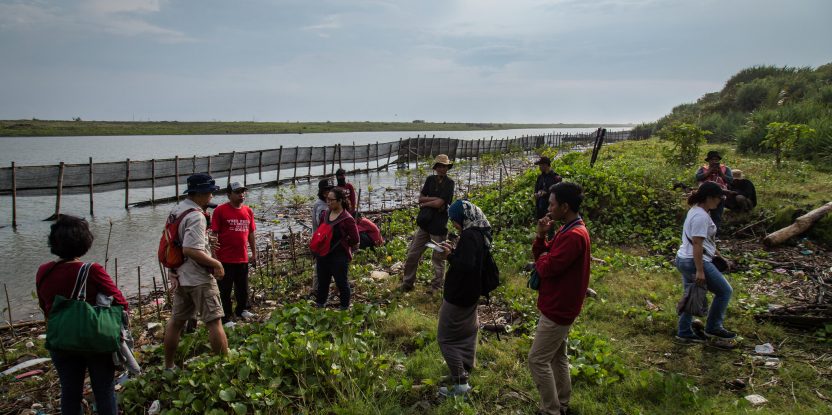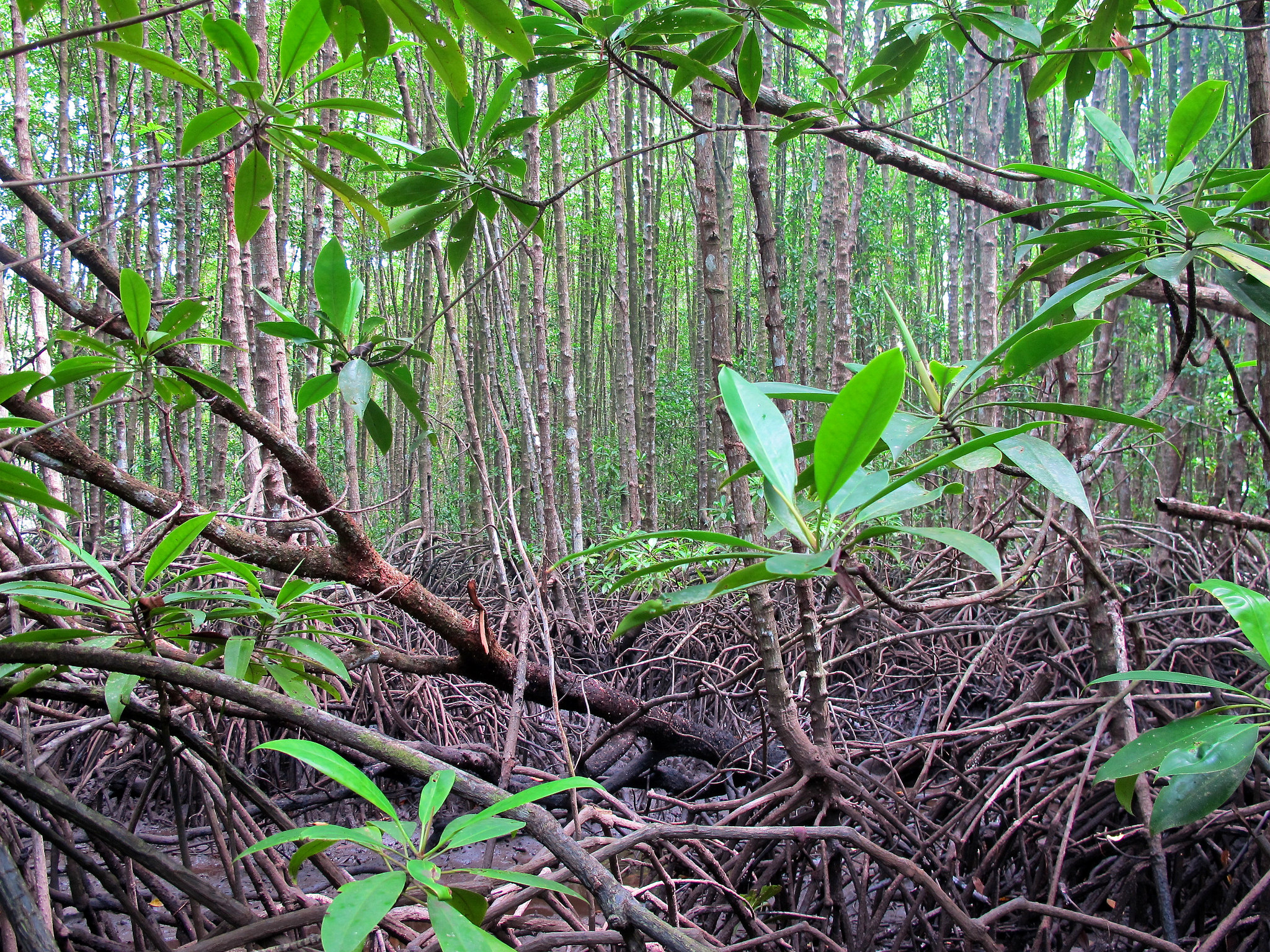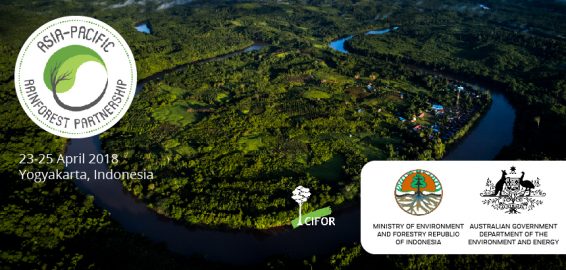
Despite growing pressures of development and urbanization, community members from Sendangsari village in Indonesia’s Yogyakarta province improved the local economy through sustainably managing their teak forest.
Surrounded by the village’s lush greenery, members of the Wono Lestari Community Forest Management Unit explained to some 20 journalists how the community accomplished this. They acquired a SVLK (Sistem Verifikasi Legalitas Kayu) license, boosting exports by allowing the EU to import their teak without due diligence. The village women also began processing previously unwanted vegetables and tubers into snacks, herbal jamu health drinks and gluten-free flours.
Ground-level sustainability efforts were at the forefront of the two-day journalism workshop, organized by the Center for International Forestry Research (CIFOR) in partnership with the Society of Indonesian Environmental Journalists (SIEJ) as part of April’s 2018 Asia-Pacific Rainforest Summit in Yogyakarta.
In addition to Sendangsari, the journalists also visited the nearby Baros Mangrove Conservation Area, where local youth have converted seven hectares of barren beach into a thriving mangrove ecosystem that’s now agriculturally viable and attracts ecotourism.
“If we use unsustainable agriculture practices with chemical fertilizers, that will adversely impact the mangroves,” said the project’s coordinator Dwi Ratmanto. “And at the same time, the mangroves serve as wind barriers protecting the agriculture inland. Before we planted the mangroves, agriculture was not effective. There was saltwater intrusion causing bad crops.
“Almost every week, we receive guests that come to plant mangroves and go bird watching.”
BURNING QUESTIONS
The workshop’s classroom sessions underlined that efforts to mitigate and adapt to climate change need to go hand-in-hand.
“Currently, there is a separation between mitigation and adaptation issues. Mitigation is more popular, and that means there are also more funds available for mitigation,” said CIFOR Scientist Hety Herawati, highlighting the number of funded efforts focused on afforestation, reforestation and biofuel.
“Dealing with climate change should be done together by everyone. As individuals, we have to reduce emissions by being more aware of our environment. Institutions can also have the same concern.”
Many of the journalists came from peat-rich provinces of Indonesia and took particular interest in learning about causes of deforestation and forest fires, such as the allure of quick cash leading communities to plant oil palm in lieu of more peat-friendly agriculture that doesn’t require artificial adjustments to the soil or dry out the land.
“I have seen farmers in South Kalimantan plant oranges and rice, but the most successful crop is pineapple,” said CIFOR Scientist Meli Fitriani Saragi-Sasmito. “It depends on the composition of minerals in the area.”
Rising demand for biofuel was raised as a driver of deforestation, often through slash-and-burn methods. Journalist Ibrahim Arsyad from South Sumatra, which experiences high levels of fire and haze on nearly an annual basis, said that companies managing fire-prone forest areas seem to only take mitigation efforts near big events, such as the upcoming 2018 Asian Games that will be held in Jakarta and Palembang in August.
Yet, omitting fires isn’t necessarily the answer.
“Forest fire is a complex problem. There is a culture of using fire to open land, because clearing land mechanically is expensive,” said Herawati. “I prefer managing the fire.”
She said that measures should be put in place to manage fires safely, such as widening breaks between burning, expanding buffer areas between clearing areas and educating communities to ensure they don’t burn during periods of long drought.
SEEING REDD+
The Indonesian news covers REDD+ less now than it has in the past.
When President Joko Widodo took office in 2014, he dissolved the REDD+ Agency and National Climate Change Council, combining their mandates under the Ministry of Environment and Forestry.
“It takes time for the government to pick up the pace again after the president prioritized institutional efficiency,” said CIFOR Scientist Cynthia Maharani.
A lack of funding for REDD+ in the national budget also prohibits the program’s growth and forces trade-offs between conservation and economic development. But there’s an uptick in local communities stepping in to fill the gap.
“At the subnational level, civil society organizations look at REDD+ as an opportunity. Many of them are already working for so long in conservation, so they are willing to put in effort even if they haven’t yet received funding to finance their activities,” said Maharani.
Now, it’s crucial to empower communities to have stable sources of income from environmental services “so it will not be easy for mining or plantation companies to come in and clear forests.”
And, beyond the money, more communities are concerning themselves with preserving healthy lifestyles. “We did this for our own benefit,” said Zuchri Saren Satrio, secretary of Sendangsari village in regards to their sustainable teak forest management. “We want to breathe clean air.”
We want you to share Forests News content, which is licensed under Creative Commons Attribution-NonCommercial-ShareAlike 4.0 International (CC BY-NC-SA 4.0). This means you are free to redistribute our material for non-commercial purposes. All we ask is that you give Forests News appropriate credit and link to the original Forests News content, indicate if changes were made, and distribute your contributions under the same Creative Commons license. You must notify Forests News if you repost, reprint or reuse our materials by contacting forestsnews@cifor-icraf.org.


